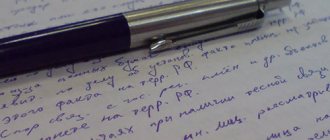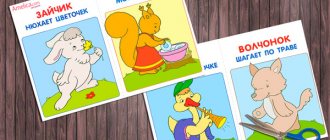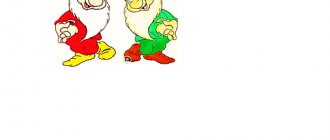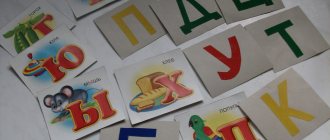Summary of a speech therapy lesson on the topic “Action words”
Theme "Action words"
Toys. Animals.
Materials: toys (train, cars, bunny, doll, parsley, bear, etc.), pictures of animals, sound symbols (circles), word symbols (stripes), counting sticks for each child, chest.
Progress of the lesson
- Organizational moment
Psycho-gymnastics. Relaxation exercises. "Wind-up toys."
Children, now you will turn into wind-up toys. Turn around yourself, turn into a Masha doll. (Children depict a doll, a dancing bear cub, a bunny playing a drum, a cheerful Parsley).
The wind-up doll is broken. (Children freeze in a certain position.)
Feel the tension. Now show me how you can relax. First drop your head, then your right arm, your left arm, then your torso. You feel very sorry for the broken doll, show how upset you are. Dad fixed the doll. And you are very happy. Show how happy you are.
- Differentiation of the concepts “sound - word”
Toys on display include a doll, a train and a hammer.
How does a doll cry? (Ah-ah-ah). What did we say? (Sound). How does the train sound? (Uh-uh-uh). Is it a sound or a word? (Sound). How does a hammer sound? (D-d-d-d. This is also a sound). Name the words - the names of the toys.
Sticks are placed on the board to represent each word spoken.
We named a lot of... (words).
Stripes are displayed - symbols of words.
Look at the stripes, these are houses of words. We will denote words with these stripes. Do you remember what words are made of? (From sounds). Make a cup with your hands, collect the sounds and say the word. (The speech therapist pronounces the words slowly, in a whisper, and the children speak loudly and together).
Kuuklaa, mmyachiik... (doll, ball). How do we designate sounds? (In circles).
Open your pencil cases, take a red circle in your right hand, and a strip like this in your left hand. What do we mean by this stripe? (Words). If I say a word, raise the bar, and if you hear a sound, raise the circle. (The speech therapist pronounces vowel sounds and words, and the children show the corresponding symbol).
- Development of speech hearing and phonemic perception
The name of each item has its own sounds. If we replace even one sound, we will not recognize the word. Now listen to me carefully, I will pronounce the words correctly and incorrectly, and you clap your hands only when you hear the correctly spoken word: bunny, kayka, plover, tukolka, doll, mukolka, ball, ryachik, vyachik.
4. Familiarization with the concept of “action words”. Updating the verb vocabulary
Children, we already know that the living and inanimate world surrounds us. What question would you ask if you wanted to know the name of a living thing? (Who is this?) About objects of the inanimate world, as you ask? (What is this?) If we want to know about the actions of humans or animals, how do we ask? (What is he doing?)
Pictures depicting a rooster, kitten, cow, hare are displayed
What does the rooster do? (Stands, crows, sings, pecks). (Selection of verbs for the words kitten, cow, hare).
These words refer to the actions of animals. Inanimate objects can fall, stand, break, or lie down. What does the doll do? (Stands, lies, walks, waves). What is Anya doing? (Instructions to perform actions are given in a whisper). (Jumps, walks, waves). The doll and Anya performed similar actions. How is the doll different from Anya? (Children's reasoning).
5. Physical training
Guess game. Now you will line up in a circle. I will close my eyes and count to five, and at this time you must make a circle. One, two, three, four, five, can I open my eyes? Guess what I'm doing? (The speech therapist imitates the action, the children repeat and name. The game continues according to the type of game actions “We won’t tell you where we were, but we’ll show you what we did”).
6. Practical mastery of singular and plural verbs
What did we do? (Danced, ran, jumped, had fun). We called action words.
A toy car is on display.
What does the machine do? (Stops, drives, honks, brakes)
Another car is added.
What do machines do? (They stand, drive, honk, brake). (Imitation of driving a car). Vanya is going, and the children... (are going). Pasha is carrying the cargo, and Tolya and Kolya... (carrying the cargo). Dima honks, and Anya and Dima ... (honk).
7. Voice and breathing exercises
A car is driving far away, its horn is barely audible. Make the sound in a whisper. Take a breath, say the sound a little louder, the car is approaching. Let's inhale again and as we exhale, pronounce the sound u loudly. The car is removed. The sound u is pronounced with the voice fading.
8. Carrying out instructions consisting of two or three actions. Mastering past tense verbs
The speech therapist gives instructions to one child in a whisper. It performs two or three actions. Children observe, then answer the question: what did Tanya do? The task is given to all children.
Stand up, take a step forward, raise your left arm, lean to the right. What have you done? (They stepped, raised their hand, bent over). What words did you use? (Action words).
9. Denotation by verbs of the work of individual human organs
What do we do with our hands? What are we doing with our feet? What does our heart do? What is our head doing? Every person should take care of their body. What should you do to have a healthy body? (Children’s reasoning. Speech therapist’s generalization).
10. Reinforcing the concepts of “action words”
“Put” the words-names of objects in the chest. (Each child has a box with counting sticks). Now put words denoting the actions of objects, animals, people. There are a lot of words in my chest. Thank you!
11. Summary of the lesson.
Lesson notes
Topic:
“Words denoting the actions of objects”
Purpose:
consolidation of the concept of “words - actions”.
Differentiation of the grammatical form of singular and plural action words. Objectives:
1. Educational - clarify knowledge about words and actions; - develop the ability to use grammatical forms (singular and plural) in speech. 2. Corrective - developmental - develop voluntary attention; - develop auditory memory; — develop fine motor skills of the hands; - develop thinking (operations of analysis, relationship with a model and generalization) 3. Educational
- develop interest in the activity,
- cultivate observation of linguistic phenomena, speech activity
— cultivate accuracy when writing in notebooks, independence when completing tasks.
Progress of the lesson
1.Org. moment
We welcome guests -
Our school teachers
You sit down very quietly
And don’t be lazy to work.
Be diligent in class, be calm and attentive. Speak clearly, clearly so that everyone can understand.
2. Psychological attitude to work.
— In every lesson you learn something new. Every day you learn more and more. I wish you to learn new and interesting things in this lesson.
-What will you be like in class? Repeat after me
Autotraining
I'll be careful.
I'll remember everything.
I want to learn new things.
I'm ready! I'm ready!
- Updating knowledge.
— How can we describe everything that surrounds us in one word?
- What questions do words-objects answer?
- The question of who is answered by living words - objects. To the question what? - inanimate words, objects. Do we underline words and objects in sentences? (one line).
— You have cards with symbols on your tables. I will show pictures, if the objects are alive, then a card with the question who? What if they are not alive?
4.Introduction to the topic
— Guys, what do you do in speech therapy classes? (We... write, read, speak)... (various answer options). “And today we will learn to pronounce words correctly and clearly, answer questions with complete answers, and tell stories.”
Guys, what day and month is it today? Season? (day, month, season).
5. Report the topic of the lesson.
Today I came to your lesson not empty-handed, but prepared a surprise. She brought a beautiful briefcase. Let's see what's in it. (The speech therapist asks each child to take an object out of the briefcase. The briefcase contains: pencils, scissors, and pen). Tanya, get the object. What do you have? (I have a pencil). Vagan, get the object. What do you have? (I have scissors). Sasha, get the item. What do you have? (I have a pen). And Ilyusha and Alyosha will answer questions. Tanya, what will you do with a pencil? (I will draw). Draw the sun. Ilyusha, what is Tanya doing? (Draws). Vagan, what are you going to do with the scissors? (I will cut). Cut the leaf. Ilyusha, what is Vagan doing? (Cuts). Sasha, what are you going to do with your pen? (I will write). Write your name. Alyosha, what is Sasha doing? (Writes0. Who was attentive? What question did I ask? (What does it do?) (Demonstration of a card with the question - “what does it do?”)
What are our guests doing? (Guests sit, watch, listen, record).
Right. Now look at the picture. (Demonstration of a picture showing students sitting and listening) - What are the students doing? (Students sit, watch, listen). The question I asked was “what are they doing?” (Demonstration of a card with the question “what are they doing?”). — How many interesting words you just named: writes, draws, cuts, sits, listens. These are all words of action. What questions do action words answer? (Draw the children’s attention to the board on which cards with questions hang:
(“What is he doing?”, “What are they doing?”). The topic of our lesson is words - actions. - Let's read it in chorus. (Children: read the title of the topic). These are very important words. Without them, we cannot tell stories, answer questions, solve riddles. Guess my riddle: There is a big and bright house. Why are there a lot of people in it? And they write and count, They create, they dream about the future. What is this? ( This is a school). What do students do at our school? (At school they write, count, decide).
6. Work on the use of words - actions that answer the question “what does it do?”, “What do they do?”
Let's look into the windows of our school and see what the kids are doing?
What is the girl doing? (The girl sings). Name the word - action. (Sings). What question does this word answer? (The word answers the question “What does it do”?) Is the action performed by one person or many? ( One man). (Under the sign with the question “what is he doing?” The word “singing” is posted) What are the children doing? (Children sing). Find the word - action. (Singing). What question does the word “sing” answer? (The word answers the question “What are they doing?”) Is the action performed by one person or many? (Many people). (Under the sign with the question - “What are they doing?” - the word “singing”) Listen to me carefully: - “What is he doing? - Singing.” “What are they doing? “They sing.” You heard that our questions are different. If an action is performed by one person, we ask the question “What is he doing?”; if the action is performed by many people, we ask the question “What are they doing?” (Draw the children’s attention to the cards on the board for visual fixation). What is the girl doing? (The girl writes). Where is the word - action? (Writes).
(The card is given to the student with the word “writes”). - What question does the word action answer? (To the question “What does it do?”) Attach the card to the correct column. (The child attaches the card to the board.) What are the children doing? (Children write). What word is action? (They write0. (The card is offered to the child with the word “write”). What question does the action word answer/ (The action word answers the question “what are they doing?”) Place the card with the word in the correct column.
What is the girl doing? (The girl is dancing.)
Where is the word - action? (Dances). What question does the action word answer? (The action word answers the question “what does it do?” Place the card with the word in the correct column. What are the children doing? (Children are dancing). Where is the action word? (Dancing). What question does the action word answer? (Action word answers the question “what are they doing?”) How many interesting things do the kids do at school. - Read the words in the first column. (Sings, writes, dances) What question do these words answer? (These words answer the question: “What does he do?”) Read the words in the second column? (They sing, write, dance). What question do these words answer? (These words answer the question: “What are they doing?”) Remember guys - If an action is performed by one person (or object), we ask a question - what does it do? And if an action is performed by several people (or objects), then we ask - what are they doing? Do you remember? Let’s repeat: if the action is performed by one person (or object), we ask the question - “What is it doing?” If the action is performed by several person (or objects), then we ask - “What are they doing?” We underline words - actions with two features. Open your notebooks and write down the words in two columns. In the first column are words that answer the question - what does it do? In the second column - what are they doing? Underline the action words with two strokes. Well done guys, close your notebooks.
7. Phys. just a minute. Speech therapist: - The guys at our school dance and sing, let’s do it too
Let's perform the movements. All the guys stood up together and walked in place. They stretched on their toes and turned to each other. We sat down like springs, and then we all sat down quietly.
We're on vacation soon. We must rest well and gain strength. It's best to relax in nature. Let's go to the forest with you. What time of year is it now? (Spring) We will go with you to the spring forest. In spring, migratory birds fly to us from the south. The forest comes to life and is filled with bird voices. Let's listen and guess whose voices are heard.
(The voice of a cuckoo, the voice of a crow, the voice of a sparrow, the hooting of an owl, the knocking of a woodpecker)
The cuckoo (what is it doing?) cuckoos. The crow (what is it doing?) croaks. The sparrow (what is he doing?) tweets. The owl (what is it doing?) hoots. The woodpecker (what is he doing?) knocks. Birds (what are they doing?) pecking, flying, hovering.
Take the cards. Write down and underline the action words.
8. Gymnastics for the eyes.
9. Compiling an oral story using words - actions. Look at the forest clearing. Who lives in a forest clearing? (Birds, hares, woodpeckers, hedgehogs) What grows in the clearing? (Trees, bushes, lilies of the valley). Let's make up a story about our forest clearing. There are proposals on your tables. Each piece of paper has a number on it. We will collect the text from the sentences in order. And instead of dots, you must choose action words, choose the appropriate one from the brackets0 I'm starting. My first suggestion. Spring came. Who has the second proposal?
2 In the forest ... (sing) birds.
Sentence 3: Woodpeckers loudly ... (knock) on the trunk.
Sentence 4: Here under the bush...(jumps) a hare.
Sentence 5: In the grass...(rustling) hedgehogs.
Sentence 6: Under the tree...(blooms) a lily of the valley.
Well done. It's time for us to go back to school.
9. Summary of the lesson. Performance evaluation. Our lesson is coming to an end. Remember what words we talked about in today's lesson. (We talked about words and actions). What questions do action words answer? (Action words answer the questions “What does it do?” “What do they do?”) That’s right, guys! How do we emphasize action words? (Two features). You worked well in class today: you were attentive, listened, and answered questions correctly. It was a pleasure to work with you. Our lesson is over.




